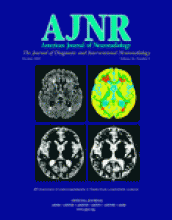Research ArticleBRAIN
Does a Relative Perfusion Measure Predict Cerebral Infarct Size?
Tobias Engelhorn, Arnd Doerfler, Michael Forsting, Gerd Heusch and Rainer Schulz
American Journal of Neuroradiology October 2005, 26 (9) 2218-2223;
Tobias Engelhorn
Arnd Doerfler
Michael Forsting
Gerd Heusch

References
- ↵Minematsu K, Fisher M, Li L, Sotak CH. Diffusion and perfusion magnetic resonance imaging studies to evaluate a non-competitive n-methyl-d-aspartate antagonist and reperfusion in experimental stroke in rats. Stroke 1993;24:2074–2081
- ↵Mueller TB, Haraldseth O, Jones RA, et al. Perfusion and diffusion-weighted MR imaging for in vivo evaluation of treatment with U74389G in a rat stroke model. Stroke 1995;26:1453–1458
- ↵Siesjo BK. Pathophysiology and treatment of focal cerebral ischemia. Part I. Pathophysiology. J Neurosurg 1992;77:169–184
- ↵Hossmann KA. Ischemia-related neuronal injury. Resuscitation 1993;26:225–235
- ↵Weisskoff RM, Chesler D, Boxerman JL, Rosen BR. Pitfalls in MR measurements of tissue blood flow with intravascular tracers: which mean transit time? Magn Reson Med 1993;29:553–558
- ↵Bassingthwaighte JB, Malone MA, Moffett TC, et al. Validity of microsphere depositions for regional myocardial flows. Am J Physiol 1987;253:184–193
- ↵Engelhorn T, Doerfler A, Kastrup A, et al. Decompressive craniectomy, reperfusion, or a combination for early treatment of acute “malignant” cerebral hemispheric stroke in rats? Potential mechanisms studied by MRI. Stroke 1999;30:1456–1463
- ↵Longa ZE, Weinstein PR, Carlson R, Cummins R. Reversible middle cerebral artery occlusion without craniectomy in rats. Stroke 1984;20:84–91
- ↵Lin TN, He YY, Wu G, et al. Effects on brain edema on infarct volume in a focal cerebral ischemia model in rats. Stroke 1993;24:117–121
- ↵Pacinos G, Watson C. The rat brain in stereotaxic coordinates. New York: Academic Press;1982
- ↵Nagasawa H, Kogure K. Correlation between cerebral blood flow and histologic changes in a rat model of middle cerebral artery occlusion. Stroke 1989;20:1037–1043
- ↵Memezawa H, Minamisawa H, Smith ML, Siesjo BK. Ischemic penumbra in a model of reversible middle cerebral artery occlusion in the rat. Exp Brain Res 1992;89:67–78
- ↵Kohno K, Hoehn-Berlage M, Mies G, et al. Relationship between diffusion-weighted MR images, cerebral blood flow, and energy state in experimental brain infarct size. Magn Reson Imaging 1995;13:73–80
- Tamura A, Graham DI, McCulloch J, Teasdale GM. Focal cerebral ischemia in the rat. 2. Regional cerebral blood flow determined by 14c-iodoantipyrine autoradiography following middle cerebral artery occlusion. J Cereb Blood Flow Metab 1981;1:61–69
- ↵Nakayama H, Dietrich WD, Watson BD, et al. Photothrombotic occlusion of rat middle cerebral artery: histopathological and hemodynamic sequelae of acute recanalization. J Cereb Blood Flow Metab 1988;8:357–366
- ↵
- ↵Quast MJ, Huang NC, Hillmann GR, Kent TA. The evolution of acute stroke recorded by multimodal magnetic resonance imaging. Magn Reson Imaging 1993;11:465–471
- ↵Rosen BR, Belliveau JM, Vevea JM, Brady TJ. Perfusion imaging with MR contrast agents. Magn Reson Med 1990;14:249–265
- ↵Bederson JB, Pitts LH, Germano SM, et al. Evaluation of 2,3,5-triphenyltetrazolium chloride as a stain for detection and quantification of experimental cerebral infarct size in rats. Stroke 1986;17:1304–1308
- ↵Cerisoli M, Ruggeri F, Amelio GF, et al. Experimental cerebral “no-reflow phenomenon.” J Neurosurg Sci 1981;25:7–12
In this issue
Advertisement
Tobias Engelhorn, Arnd Doerfler, Michael Forsting, Gerd Heusch, Rainer Schulz
Does a Relative Perfusion Measure Predict Cerebral Infarct Size?
American Journal of Neuroradiology Oct 2005, 26 (9) 2218-2223;
0 Responses
Jump to section
Related Articles
- No related articles found.
Cited By...
- Predicting experimental success: a retrospective case-control study using the rat intraluminal thread model of stroke
- Congenic Fine-Mapping Identifies a Major Causal Locus for Variation in the Native Collateral Circulation and Ischemic Injury in Brain and Lower Extremity
- MicroRNA Expression in the Blood and Brain of Rats Subjected to Transient Focal Ischemia by Middle Cerebral Artery Occlusion
This article has not yet been cited by articles in journals that are participating in Crossref Cited-by Linking.
More in this TOC Section
Similar Articles
Advertisement











